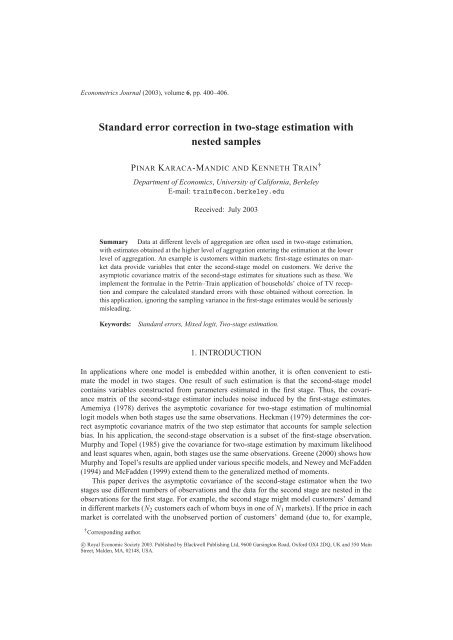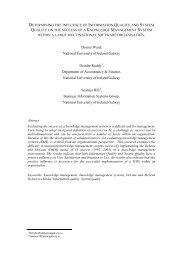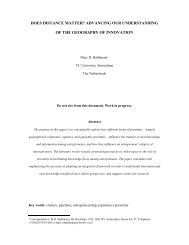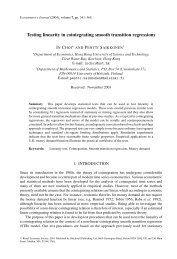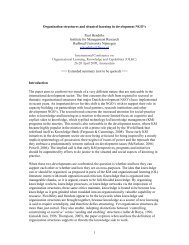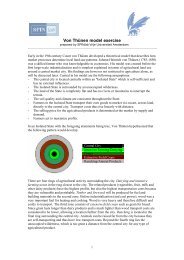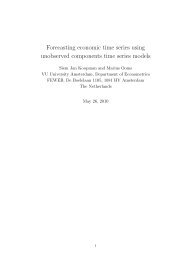Pinar Karaca-Mandic and Kenneth Train, (2003), pp. 400 ... - Feweb
Pinar Karaca-Mandic and Kenneth Train, (2003), pp. 400 ... - Feweb
Pinar Karaca-Mandic and Kenneth Train, (2003), pp. 400 ... - Feweb
You also want an ePaper? Increase the reach of your titles
YUMPU automatically turns print PDFs into web optimized ePapers that Google loves.
Econometrics Journal (<strong>2003</strong>), volume 6, <strong>pp</strong>. <strong>400</strong>–406.<br />
St<strong>and</strong>ard error correction in two-stage estimation with<br />
nested samples<br />
PINAR KARACA-MANDIC AND KENNETH TRAIN †<br />
Department of Economics, University of California, Berkeley<br />
E-mail: train@econ.berkeley.edu<br />
Received: July <strong>2003</strong><br />
Summary Data at different levels of aggregation are often used in two-stage estimation,<br />
with estimates obtained at the higher level of aggregation entering the estimation at the lower<br />
level of aggregation. An example is customers within markets: first-stage estimates on market<br />
data provide variables that enter the second-stage model on customers. We derive the<br />
asymptotic covariance matrix of the second-stage estimates for situations such as these. We<br />
implement the formulae in the Petrin–<strong>Train</strong> a<strong>pp</strong>lication of households’ choice of TV reception<br />
<strong>and</strong> compare the calculated st<strong>and</strong>ard errors with those obtained without correction. In<br />
this a<strong>pp</strong>lication, ignoring the sampling variance in the first-stage estimates would be seriously<br />
misleading.<br />
Keywords: St<strong>and</strong>ard errors, Mixed logit, Two-stage estimation.<br />
1. INTRODUCTION<br />
In a<strong>pp</strong>lications where one model is embedded within another, it is often convenient to estimate<br />
the model in two stages. One result of such estimation is that the second-stage model<br />
contains variables constructed from parameters estimated in the first stage. Thus, the covariance<br />
matrix of the second-stage estimator includes noise induced by the first-stage estimates.<br />
Amemiya (1978) derives the asymptotic covariance for two-stage estimation of multinomial<br />
logit models when both stages use the same observations. Heckman (1979) determines the correct<br />
asymptotic covariance matrix of the two step estimator that accounts for sample selection<br />
bias. In his a<strong>pp</strong>lication, the second-stage observation is a subset of the first-stage observation.<br />
Murphy <strong>and</strong> Topel (1985) give the covariance for two-stage estimation by maximum likelihood<br />
<strong>and</strong> least squares when, again, both stages use the same observations. Greene (2000) shows how<br />
Murphy <strong>and</strong> Topel’s results are a<strong>pp</strong>lied under various specific models, <strong>and</strong> Newey <strong>and</strong> McFadden<br />
(1994) <strong>and</strong> McFadden (1999) extend them to the generalized method of moments.<br />
This paper derives the asymptotic covariance of the second-stage estimator when the two<br />
stages use different numbers of observations <strong>and</strong> the data for the second stage are nested in the<br />
observations for the first stage. For example, the second stage might model customers’ dem<strong>and</strong><br />
in different markets (N2 customers each of whom buys in one of N1 markets). If the price in each<br />
market is correlated with the unobserved portion of customers’ dem<strong>and</strong> (due to, for example,<br />
† Corresponding author.<br />
c○ Royal Economic Society <strong>2003</strong>. Published by Blackwell Publishing Ltd, 9600 Garsington Road, Oxford OX4 2DQ, UK <strong>and</strong> 350 Main<br />
Street, Malden, MA, 02148, USA.
St<strong>and</strong>ard error correction in two-stage estimation with nested samples 401<br />
an omitted product attribute), then some form of instrumental variables estimation is needed to<br />
account for this correlation. The first stage specifies price as a function of instruments using<br />
market-level data, <strong>and</strong> the second stage utilizes the predicted price or the residual in estimation<br />
of the customer-level model.<br />
Kuksov <strong>and</strong> Villas-Boas (2001) derive a similar formula for a related set-up. Their samples<br />
are not nested; instead, each unit of observation in the second stage a<strong>pp</strong>ears repeatedly in all<br />
of the first-stage observations (i.e. each customer is observed in each of several time periods.)<br />
They allow correlation over first-stage observations in the unobservables associated with each<br />
second-stage unit (i.e. correlation for the same customer over time). In contrast, our formula uses<br />
independence over first-stage observations.<br />
We a<strong>pp</strong>ly our formula to the Petrin–<strong>Train</strong> a<strong>pp</strong>lication of households’ choice of TV reception.<br />
They are concerned that the prices of the TV reception alternatives are correlated with the<br />
unobserved attributes of the alternatives. To correct for this endogeneity, they specify a firststage<br />
linear regression of prices on exogenous variables <strong>and</strong> instrumental variables using market<br />
level data. The second stage is a mixed logit model. The dependent variable is the TV reception<br />
choice of a customer in a given market, <strong>and</strong> the independent variables are market level<br />
prices, market level residuals estimated in the first stage <strong>and</strong> other observed attributes of the<br />
alternatives.<br />
2. FRAMEWORK<br />
First stage. Estimated parameters ˆθ1 solve moment conditions ¯h( ˆθ1) = 0 where ¯h(θ1) =<br />
1<br />
N1<br />
<br />
m hm(θ1, zm), N1 is the number of observations, <strong>and</strong> hm(θ1; zm) is a vector of moments for<br />
observation m which depends on data zm.<br />
Second stage. Estimated parameters ˆθ2 solve moment conditions ¯g( ˆθ2, ˆθ1) = 0 where ¯g(θ2, ˆθ1)<br />
= 1 <br />
N2 n gn(θ2, ˆθ1; xn), N2 is the number of observations, <strong>and</strong> gn(θ2, ˆθ1; xn) is the moment for<br />
observation n based on its data <strong>and</strong> the first-stage estimates.<br />
Each n in the second stage corresponds to an m in the first stage (e.g. n indexes customers,<br />
m indexes markets, <strong>and</strong> each customer buys in one market). Therefore, there are one or more<br />
observations in the second-stage sample from each group in the first-stage sample. Also, xn in<br />
the second stage can include one or more elements of zm for the m corresponding to n.<br />
Take a Taylor expansion of both the first- <strong>and</strong> second-stage moment conditions around the<br />
true parameters θ ∗ 1 <strong>and</strong> θ ∗ 2 (assuming that the moment conditions are bounded <strong>and</strong> differentiable<br />
around the true parameters) <strong>and</strong> evaluate it asymptotically. For the first stage:<br />
<strong>and</strong> for the second stage:<br />
where<br />
c○ Royal Economic Society <strong>2003</strong><br />
0 a = ¯h(θ ∗ 1 ) − A( ˆθ1 − θ ∗ 1 ),<br />
0 a = ¯g(θ ∗ 2 , θ ∗ 1 ) − B( ˆθ1 − θ ∗ 1 ) − C( ˆθ2 − θ ∗ 2 ),<br />
A = −plim∇θ1 ¯h(θ ∗ 1 )<br />
B = −plim∇θ1 ¯g(θ ∗ 2 , θ ∗ 1 )<br />
C = −plim∇θ2 ¯g(θ ∗ 2 , θ ∗ 1 ),
402 <strong>Pinar</strong> <strong>Karaca</strong>-<strong>M<strong>and</strong>ic</strong> <strong>and</strong> <strong>Kenneth</strong> <strong>Train</strong><br />
<strong>and</strong> where a = denotes equality up to asymptotically negligible remainder terms. 1 Then<br />
<strong>and</strong><br />
( ˆθ1 − θ ∗ 1 ) a = A −1 ¯h(θ ∗ 1<br />
1 ) = A−1<br />
N1<br />
n<br />
<br />
m<br />
hm(θ ∗ 1 , zm),<br />
( ˆθ2 − θ ∗ 2 ) a = C −1 ( ¯g(θ ∗ 2 , θ ∗ 1 ) − B( ˆθ1 − θ ∗ 1 ))<br />
a<br />
= C −1<br />
<br />
1 <br />
gn(θ<br />
N2<br />
∗ 2 , θ ∗ 1 ; xn)<br />
−1 1 <br />
− B A hm(θ<br />
N1<br />
∗ <br />
1 , zm) . (1)<br />
Given that the N2 second-stage observations can be grouped into N1 first-stage observations, we<br />
can re-write<br />
N2<br />
N1<br />
<br />
N<br />
gn(θ2, θ1; xn) =<br />
m<br />
<br />
gℓm(θ2, θ1; xℓm),<br />
n=1<br />
m=1 ℓ=1<br />
where N m is the number of observations among the N2 second-stage observations that correspond<br />
to observation m of the first stage (e.g. number of customers in market m) <strong>and</strong> gℓm is the<br />
second-stage moment for the ℓth second-stage observation that corresponds to the mth first-stage<br />
observation. Then equation (1) becomes<br />
⎡<br />
⎤<br />
( ˆθ2 − θ ∗ 2 ) a = C −1<br />
⎣ 1<br />
N2<br />
N1 N m<br />
<br />
m=1 ℓ=1<br />
or, expressed more conveniently,<br />
( ˆθ2 − θ ∗ 2 ) a = C −1<br />
⎡<br />
⎣ 1<br />
N1 N<br />
N1<br />
m<br />
<br />
N1<br />
N2<br />
m=1 ℓ=1<br />
gℓm(θ ∗ 2 , θ ∗ 1 ; xℓm)<br />
−1 1<br />
− B A<br />
N1<br />
gℓm(θ ∗ 2 , θ ∗ 1 ; xℓm)<br />
−1 1<br />
− B A<br />
N1<br />
m<br />
N1 <br />
hm(θ<br />
m=1<br />
∗ 1<br />
N1 <br />
hm(θ<br />
m=1<br />
∗ 1<br />
, zm) ⎦<br />
Define ˜gm = N m<br />
N1<br />
ℓ=1 C−1<br />
N2 gℓm(θ ∗ 2 , θ ∗ 1 ; xℓm) <strong>and</strong> ˜hm = C−1 B A−1hm(θ ∗ 1 , zm). Then:<br />
N1( ˆθ2 − θ ∗ 2 ) a = 1<br />
√ N1<br />
Finally, letting Xm = ˜gm − ˜hm, we have<br />
N1 <br />
m=1<br />
N1( ˆθ2 − θ ∗ 2 ) a = 1<br />
√ N1<br />
( ˜gm − ˜hm).<br />
N1 <br />
m=1<br />
Xm.<br />
⎤<br />
, zm) ⎦ .<br />
Asymptotically, √ N1( ˆθ2 −θ ∗ 2 ) a a<br />
∼ N(0, Var(Xm)), such that ˆθ2 ∼ N(θ ∗ 2 , Var(Xm)/N1). Var(Xm)<br />
is a<strong>pp</strong>roximated by its sample analog, 1 <br />
N1 m ˆXm ˆX ′ m , with ˆXm calculated at the estimated parameters<br />
(<strong>and</strong> A, B, <strong>and</strong> C replaced by sample analogs). This is a re-expression of the Murphy<br />
1 A <strong>and</strong> C are square matrices in this notation, such that the parameters are exactly identified by the moment conditions.<br />
The notation can of course be generalized.<br />
c○ Royal Economic Society <strong>2003</strong>
St<strong>and</strong>ard error correction in two-stage estimation with nested samples 403<br />
<strong>and</strong> Topel (1985) result for an a<strong>pp</strong>lication in which the correlation in the r<strong>and</strong>om components<br />
of the first <strong>and</strong> second steps take a particular form due to the nested structure of the data. Note<br />
that if there is no error in the first stage (i.e. hm(θ ∗ 1 ) = 0 ∀m), then this formula for the asymptotic<br />
covariance becomes the robust covariance estimator of ˆθ2 that allows for correlation over<br />
observations within each market. 2 Also note that these formulae assume that N1 → ∞, though<br />
Var(Xm) will decline as N2 increases as well.<br />
3. APPLICATION<br />
We adapt <strong>and</strong> a<strong>pp</strong>ly the formula to the model of Petrin <strong>and</strong> <strong>Train</strong> (2002). Their model is a mixed<br />
logit of choice at the consumer level that uses an explanatory variable that is estimated by regression<br />
on market level data. They examine customers’ choice of TV reception, with the alternatives<br />
being: antenna only, cable with basic or extended service, cable with premium packages, or satellite.<br />
Each customer lives in a franchise area, called a market, <strong>and</strong> the price <strong>and</strong> other attributes<br />
of the alternatives vary over markets. Some attributes of the alternatives, such as quality of programming,<br />
are not measurable <strong>and</strong> hence not included as explanatory variables in the customer<br />
choice model. Since the omitted attributes are expected to be related to price, their omission<br />
induces correlation between the unobserved portion of utility <strong>and</strong> price. One of the ways they<br />
address this correlation is through a control function a<strong>pp</strong>roach; in particular, they regress market<br />
price against market-level instruments <strong>and</strong> then enter the residual of this price regression as an<br />
explanatory variable in the customer-level choice model. Unobserved utility conditional on this<br />
price residual need not be correlated with price; the density of this conditional unobserved utility<br />
determines the form of the choice model.<br />
The model is specified as follows. The first stage consists of OLS a<strong>pp</strong>lied to linear<br />
regressions:<br />
pmj = β ′ j zm + µmj,<br />
where pmj is the price of alternative j in market m <strong>and</strong> zm are instruments. The estimated residuals<br />
ˆµmj = pmj − ˆβ ′ j zm are calculated. The utility that customer n who resides in market m<br />
obtains from alternative j is specified as<br />
Unmj = α ′ wnmj + λ jµmj + εnmj.<br />
The explanatory variables wnmj include the price <strong>and</strong> other observed attributes of alternative j<br />
in market m, interacted in some cases with demographics of the customer. In estimation, the ˆµmj<br />
is used in lieu of the true µmj. Petrin <strong>and</strong> <strong>Train</strong> assume that the error εnmj contains a component<br />
that is normally distributed <strong>and</strong> common to all non-antenna alternatives, plus an i.i.d. extreme<br />
value term. Their choice model is therefore a mixed logit, with mixing over the normal error<br />
component.<br />
The price of antenna only is zero for all customers, <strong>and</strong> the price of satellite does not vary<br />
over markets. Price regressions are therefore estimated only for the two cable alternatives, <strong>and</strong><br />
only the utility for these two alternatives includes price residuals. The two cable alternatives are<br />
denoted j = 2, 3.<br />
2 The robust covariance estimator is the ‘cluster’ estimator implemented by Rogers (1993) <strong>and</strong> marketed by Stata.<br />
c○ Royal Economic Society <strong>2003</strong>
404 <strong>Pinar</strong> <strong>Karaca</strong>-<strong>M<strong>and</strong>ic</strong> <strong>and</strong> <strong>Kenneth</strong> <strong>Train</strong><br />
With this specification, we have θ ′ 1 = 〈β′ 2 , β′ 3 〉 <strong>and</strong> θ ′ 2 = 〈α′ , λ2, λ3〉. The first-stage moments<br />
are h ′ m = 〈zmµm2, zmµm2〉 <strong>and</strong> the second-stage moments are gnm = ∇θ2 Lnm(θ2, ˆθ1), where<br />
Lnm is the log-likelihood for customer n in market m. We need to calculate A, B <strong>and</strong> C.<br />
Matrix A is the expected moment matrix of the instruments. Let Z be the matrix whose mth<br />
row is z ′ m<br />
. Then A is a<strong>pp</strong>roximated by its sample analog,<br />
<br />
Z ′ Z/N1 0<br />
0 Z ′ <br />
.<br />
Z/N1<br />
Matrix C is the negative of the expected Hessian in the second-stage model evaluated at the<br />
true parameters: C = −∇θ2θ2 L(θ ∗ 2 , θ ∗ 1 ), where L is the expected log-likelihood of an observation.<br />
Using the information identity, C can be a<strong>pp</strong>roximated by the sample variance of the scores at<br />
the estimated parameters,<br />
1<br />
N1 N m<br />
N2<br />
m=1 ℓ=1<br />
<br />
∇θ2 Lℓm( ˆθ2, ˆθ1)∇θ2 Lℓm( ˆθ2, ˆθ1) ′ ,<br />
where Lℓm is the log-likelihood for the ℓth household in market m.<br />
Matrix B is the expected derivative of the second-stage scores with respect to the first-stage<br />
parameters: B = −∇θ2θ1 L(θ ∗ 2 , θ ∗ 1 ). Analogous to the proof for the information identity, B =<br />
N1<br />
m=1<br />
N m<br />
ℓ=1 ∇θ2 Lℓm( ˆθ2, ˆθ1)∇θ1<br />
∇θ2L(θ ∗ 2 , θ ∗ 1 )∇θ1L(θ ∗ 2 , θ ∗ 1 )′ . Its empirical analog is therefore 1 N2<br />
Lℓm( ˆθ2, ˆθ1) ′ . The first term is the score. The second term takes a particularly convenient form in<br />
this a<strong>pp</strong>lication. Note that<br />
∂ Lℓm<br />
=<br />
∂λ j<br />
1 ∂ Pℓm<br />
Pℓm ∂(λ jµmj) µmj,<br />
where Pℓm is the probability of the chosen alternative of the ℓth customer in market m. Since, by<br />
definition, µmj = pmj − β ′ j zm, we have<br />
∂ Lℓm<br />
∂β k j<br />
= 1 ∂ Pℓm ∂λ jµmj<br />
Pℓm ∂(λ jµmj) ∂βk j<br />
= 1<br />
Pℓm<br />
∂ Pℓm<br />
∂(λ jµmj) (−λ j z k <br />
∂ Lℓm<br />
m ) = −<br />
∂λ j<br />
λ j<br />
µm j zk <br />
m ,<br />
where superscript k refers to the kth element of β j <strong>and</strong> zm. Then, collecting elements, we have:<br />
∇θ1 Lℓm(<br />
<br />
∇λ2 ˆθ2, ˆθ1) = −<br />
Lℓm( ˆθ2, ˆθ1) ˆλ2<br />
ˆµm2 zm<br />
∇λ3 Lℓm( ˆθ2, ˆθ1) ˆλ3<br />
ˆµm3 zm<br />
<br />
.<br />
Using these quantities, Xm is calculated as<br />
Xm =<br />
N m<br />
<br />
C<br />
ℓ=1<br />
−1 N1<br />
N2<br />
gℓm( ˆθ2, ˆθ1; xℓm) − C −1 B A −1 hm( ˆθ1, zm),<br />
where the terms A, B, C, gℓm, <strong>and</strong> hm are defined as above. The covariance of the second-stage<br />
estimator is then calculated as the empirical covariance of Xm over the markets in the sample,<br />
divided by N1.<br />
Table 1 gives the estimated model from Petrin <strong>and</strong> <strong>Train</strong> (2002). The first column of st<strong>and</strong>ard<br />
errors is calculated from the formulae just described. The second column gives the st<strong>and</strong>ard<br />
c○ Royal Economic Society <strong>2003</strong>
St<strong>and</strong>ard error correction in two-stage estimation with nested samples 405<br />
Table 1. Mixed logit model of TV reception choice.<br />
Explanatory variable Estimates St<strong>and</strong>ard errors<br />
Asympt. formula Uncorrected<br />
Price, in dollars per month (1–4) −0.0969 0.0407 0.0174<br />
Price for income group 2 (1–4) 0.0150 0.0023 0.0024<br />
Price for income group 3 (1–4) 0.0247 0.0033 0.0030<br />
Price for income group 4 (1–4) 0.0269 0.0035 0.0033<br />
Price for income group 5 (1–4) 0.0308 0.0034 0.0036<br />
Number of cable channels (2,3) 0.0026 0.0035 0.0015<br />
Number of premium channels (3) 0.0448 0.0243 0.0162<br />
Number of over-the-air channels (1) 0.0222 0.0151 0.0089<br />
Whether pay per view is offered (2,3) 0.5813 0.1741 0.0761<br />
Indicator: ATT is cable company (2) −0.1949 0.2388 0.1060<br />
Indicator: ATT is cable company (3) −0.2370 0.2345 0.1199<br />
Indicator: Adelphia Comm is cable company (2) 0.3425 0.2932 0.1224<br />
Indicator: Adelphia Comm is cable company (3) 0.2392 0.3030 0.1491<br />
Indicator: Cablevision is cable company (2) 0.1342 0.3608 0.2402<br />
Indicator: Cablevision is cable company (3) 0.7350 0.3838 0.2516<br />
Indicator: Charter Comm is cable company (2) −0.0580 0.2311 0.1006<br />
Indicator: Charter Comm is cable company (3) −0.1757 0.1856 0.1270<br />
Indicator: Comcast is cable company (2) −0.0938 0.3682 0.1190<br />
Indicator: Comcast is cable company (3) 0.1656 0.2723 0.1316<br />
Indicator: Cox Comm is cable company (2) −0.0577 0.3267 0.1475<br />
Indicator: Cox Comm is cable company (3) 0.0874 0.4386 0.1691<br />
Indicator: Time-Warner is cable company (2) −0.0817 0.2261 0.0995<br />
Indicator: Time-Warner is cable company (3) −0.0689 0.2017 0.1203<br />
Education level of household (2) −0.0619 0.0267 0.0220<br />
Education level of household (3) −0.1123 0.0329 0.0278<br />
Education level of household (4) −0.1967 0.0367 0.0368<br />
Household size (2) −0.0518 0.0290 0.0240<br />
Household size (3) 0.0134 0.0291 0.0287<br />
Household size (4) 0.0050 0.0447 0.0358<br />
Household rents dwelling (2–3) −0.2436 0.0913 0.0863<br />
Household rents dwelling (4) −0.2149 0.1327 0.1562<br />
Single family dwelling (4) 0.7649 0.2022 0.1521<br />
Residual for extended-basic cable price (2) 0.0805 0.0422 0.0177<br />
Residual for premium cable price (4) 0.0873 0.0423 0.0178<br />
Alternative specific constant (2) 2.972 0.8984 0.5012<br />
Alternative specific constant (3) 2.903 1.379 0.6904<br />
Alternative specific constant (4) 4.218 2.319 1.087<br />
Error components, st<strong>and</strong>ard deviation (2–4) 0.5553 0.6826 0.6410<br />
Log-likelihood at convergence: −14635.47<br />
Number of observations: 11810<br />
Alternatives: (1) Antenna only, (2) basic <strong>and</strong> extended cable, (3) premium cable, (4) satellite. Variables enter alternatives<br />
in parentheses <strong>and</strong> zero in other alts.<br />
c○ Royal Economic Society <strong>2003</strong>
406 <strong>Pinar</strong> <strong>Karaca</strong>-<strong>M<strong>and</strong>ic</strong> <strong>and</strong> <strong>Kenneth</strong> <strong>Train</strong><br />
errors that are produced by the st<strong>and</strong>ard maximum likelihood estimation routine, which treats<br />
the estimated price residuals as true. In this a<strong>pp</strong>lication, ignoring the sampling variance in the<br />
first-stage estimates would be seriously misleading. For example, the st<strong>and</strong>ard error on the base<br />
price coefficient rises from 0.0174 without correction to 0.0407 when the first-stage sampling<br />
variance is considered. 3 As expected, the st<strong>and</strong>ard error correction has the greatest impact for<br />
the base price coefficient <strong>and</strong> the coefficients of the price residuals. The impact is minimal for<br />
the demographic variables.<br />
ACKNOWLEDGEMENT<br />
We gratefully acknowledge the assistance of James Powell.<br />
REFERENCES<br />
Amemiya, T. (1978). On two-step estimation of multivariate logit models. Journal of Econometrics 8,<br />
13–21.<br />
Greene, W. (2000). Econometric Analysis, 4th edn. U<strong>pp</strong>er Saddle River, NJ: Prentice-Hall.<br />
Heckman, J. (1979). Sample selection bias as a specification error. Econometrica 47, 153–62.<br />
Kuksov, D. <strong>and</strong> M. Villas-Boas (2001). Endogeneity <strong>and</strong> individual customer choice. Working Paper,<br />
Haas School of Business, University of California, Berkeley, http://groups.haas.berkeley.edu/<br />
marketing/PAPERS/VILLAS/Paper.pdf.<br />
McFadden, D. (1999). Economics 240b, Lecture Notes. Department of Economics, University of California,<br />
Berkeley, http://emlab.berkeley.edu/users/mcfadden/e240b\_f01/ch3.pdf.<br />
Murphy, K. <strong>and</strong> R. Topel (1985). Estimation <strong>and</strong> inference in two step econometric models. Journal of<br />
Business <strong>and</strong> Economic Statistics 3, 370–9.<br />
Newey, W. <strong>and</strong> D. McFadden (1994). Large sample estimation <strong>and</strong> hypothesis testing. In Z. Griliches <strong>and</strong><br />
M. Intriligator (eds), The H<strong>and</strong>book of Econometrics, vol. 4, <strong>pp</strong>. 2111–245. Amsterdam: Elsevier Science<br />
Publishers.<br />
Petrin, A. <strong>and</strong> K. <strong>Train</strong> (2002). Omitted product attributes in discrete choice models. Working Paper,<br />
Department of Economics, University of California, Berkeley, http://elsa.berkeley.edu/wp/<br />
train1202.pdf.<br />
Rogers, W. H. (1993). Regression st<strong>and</strong>ard errors in clustered samples. Stata Technical Bulletin 13, 19–23.<br />
(Reprinted in Stata Technical Bulletin Reprints, vol. 3, 88–94).<br />
3 For the second-stage st<strong>and</strong>ard errors, Petrin <strong>and</strong> <strong>Train</strong> (2002) use a bootstrap method that can be a<strong>pp</strong>lied with canned<br />
software, unlike the matrix manipulations required by the formula in this paper. Details of the bootstrap procedure can<br />
be found in Petrin <strong>and</strong> <strong>Train</strong> (2002). The st<strong>and</strong>ard errors based on the asymptotic formula <strong>and</strong> the bootstrap are similar.<br />
For example, the price coefficient receives a st<strong>and</strong>ard error of 0.0407 using the asymptotic formula <strong>and</strong> 0.0<strong>400</strong> using the<br />
bootstrap procedure. The st<strong>and</strong>ard error on the number of cable channels is 0.0035 using the asymptotic formula <strong>and</strong><br />
0.0029 using the bootstrap procedure. This similarity suggests that bootstra<strong>pp</strong>ing on the first-stage regression provides<br />
reasonable st<strong>and</strong>ard errors <strong>and</strong> can perhaps serve as a useable method for researchers who do not want to program the<br />
asymptotic formula.<br />
c○ Royal Economic Society <strong>2003</strong>


